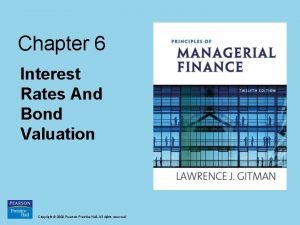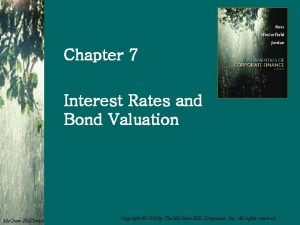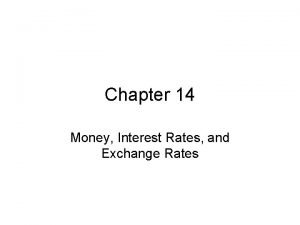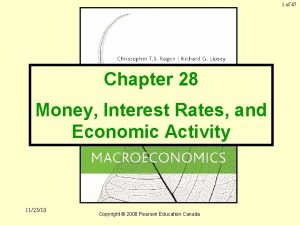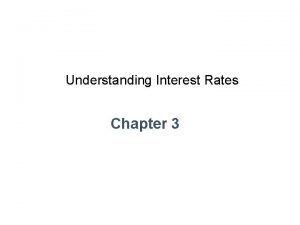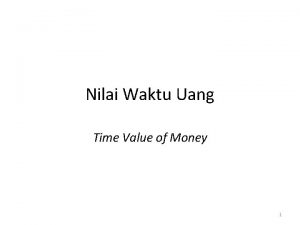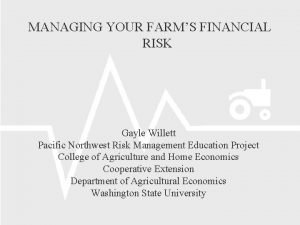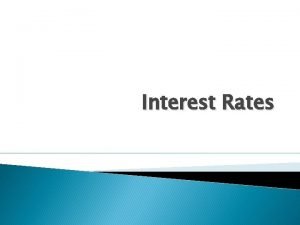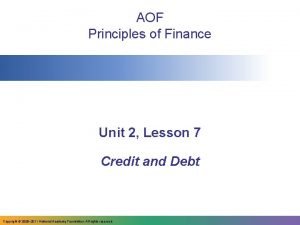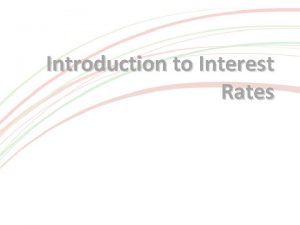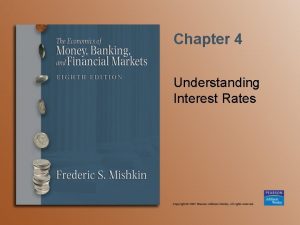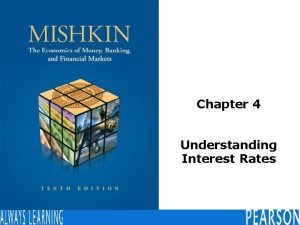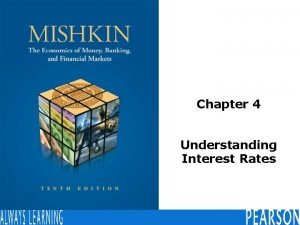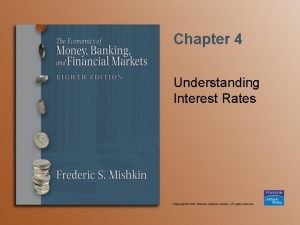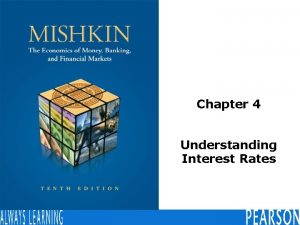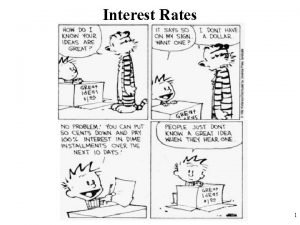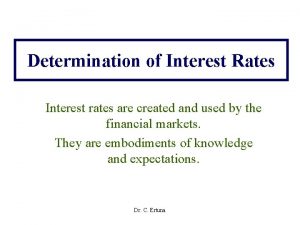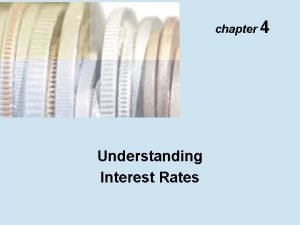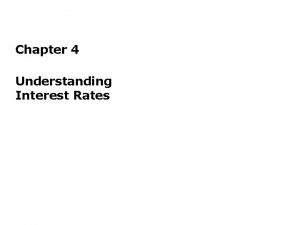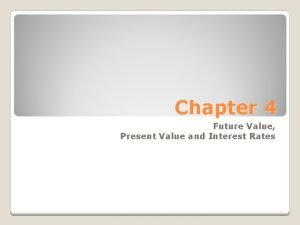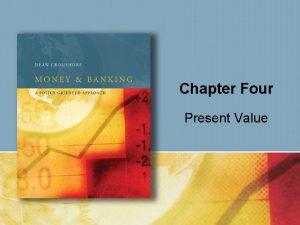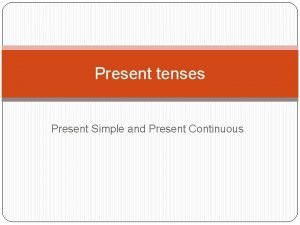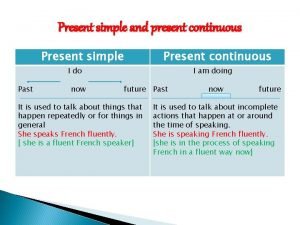Interest Rates and Present Value Chapter 7 Interest





















- Slides: 21

Interest Rates and Present Value Chapter 7

Interest rates • We have thought about people trading fish and hamburgers lets think about a different type of trade • Joe would like to trade coconuts that will be ripe tomorrow in order to get ripe coconuts today • Bill is willing to trade some of the coconuts he has today in order to get coconuts tomorrow. • At what rate will they trade in a competitive market? • For quite a few reasons we think if Bill is going to give up 10 coconuts today he is going to want more than 10 coconuts back tomorrow • This is called interest 2

Why Do we want more tomorrow? • People are impatient-all else equal I would rather have a candy bar today than wait for it until tommorow • There is some risk that Joe will die or renege on his promise (the larger the risk of this the more interest we will want) • I might be able to do something useful with the coconuts (or money) in the meantime • Use the coconuts to build a shelter that I can live in (and if this is money I could buy a house today, live in it, and then sell the house tomorrow) • Use it to buy an ice cream truck, make money selling ice cream, and then sell the ice cream truck at the end of the day • Or if some emergency comes up and I need the money right away, I don’t have it and need to wait until I get paid back 3

Interest Rate • The interest rate is the percentage, usually expressed in annual terms, of a balance that is paid by a borrower to a lender that is in addition to the original amount borrowed or lent. • If I trade 100 coconuts today for 108 coconuts next year, the interest rate is 8% • As a practical matter it doesn’t usually work this way: Banks act as intermediaries • Joe borrows coconuts from the bank • Bill saves his coconuts in the bank • While they never actually meet each other-Joe is essentially borrowing from Bill 4

Nominal vs. Real Interest Rates • Nominal Interest Rate: the advertised rate of interest • Real Interest Rate: the rate of interest after inflation expectations are accounted for; the compensation for waiting on consumption • As an example suppose the inflation rate is 10% and the nominal interest rate is 10% • I put $100 into my account this year (2011) • I get $110 next year (2012) • However, that $110 in 2012 is worth the same amount as $100 in 2011, so I didn’t really earn any interest • In that case the real interest rate would be 0 • I would probably want to spend that $100 now before inflation erodes its value • In economics we usually care about the real interest rate 5

Present Value • Present Value is the interest adjusted value of future payment streams. • To think of this consider two different scenarios: 1. I pay you $300 this year 2. I pay you $100 this year, $100 in 2012, and $100 in 2013 • The interest rate is 5% • Are these the same? • Think about it this way: 1. I get my $300 now, spend $100 and save $200 • Next year I have $210 in the bank, I spend $110 and save $100 • In 2013 I now have $105 to spend 6

• Obviously I prefer the $300 today. • This is because the present value of a stream of $100 for three years is less than $300. • Well how much is it exactly? • The present value of the first $100 today is $100 • The present value of $100 next year must solve the following equation (r is the interest rate) That is, if I put PV in the bank today, I will have $100 in the bank tomorrow 7

So Now what about the present value of $100 in 2012? To see where this comes from suppose • I put $Y into the bank in 2011. • This would be give me $Y(1+r) in 2012 • If I just kept it in the bank I would get $Y(1+r) in 2013 Thus the present value of $100 in 2013 is: 8

And the value of the stream of $100 for 3 years is worth: More generally the present value of a payment $Y n years from now is worth today Rather than doing more calculations lets look at what this means 9

The Amount Payable for Every Dollar Borrowed (For several interest rates and loan durations) Interest rate -> Years ↓ 20% 10% 5% 2% 1% 30 237. 38 17. 45 4. 32 1. 81 1. 35 10 6. 19 2. 59 1. 63 1. 22 1. 10 5 2. 49 1. 61 1. 28 1. 10 1. 05 1 1. 20 1. 10 1. 05 1. 02 1. 01 10

Examples From This Table • If you borrow $1 and promise to pay it back in 5 years at 5% interest you will owe $1. 28 which is the original $1 plus 28 cents in interest. • If you borrow $1 and promise to pay it back in 30 years at 20% interest you will owe $237. 38 which is the original $1 plus $236. 38 in interest. 11

Business Venture • Suppose you have the following business venture: • Invest $100 into the venture for 5 years • receive $100 in proceeds starting in year 6 and lasting for 7 years • Is this a good investment? • It depends on the interest rate 12

A Multiple Year Example @ 5% Year Cost Benefit PV Cost @5% 1 100. 00 2 100 95. 24 3 100 90. 70 4 100 86. 38 5 100 82. 27 This is a good deal PV Benefit @5% 6 100 78. 35 7 100 74. 62 8 100 71. 07 9 100 67. 68 10 100 64. 46 11 100 61. 39

A Multiple Year Example @ 8% Year Cost Benefit PV Cost @8% 1 100. 00 2 100 92. 59 3 100 85. 73 4 100 79. 38 5 100 73. 50 PV Benefit @8% 6 100 68. 06 7 100 8 100 9 100 54. 03 10 100 50. 02 11 100 46. 32 Not a good deal at this interest rate 63. 02 58. 35

Internal rate of return • At 5% (or less) this was a good investment • At 8% (or more) this is a bad investment • Internal rate of return : The interest rate where the present value of costs and benefits are equal. • If my interest rate is lower than the internal rate, I should do it • If it is higher than the internal rate, I should not do it 15

Mortgages, Car Payments, Etc. • Mortgages are loans taken out to buy homes. Typically you borrow a large sum of money and promise to pay it back in even amounts each month for 10, 15, or 30 years. • Car loans are similar to mortgages in that you borrow a large sum but the loan duration is usually two to six years. • How does the financing department figure out the monthly payment at a 2. 9% interest for a $32, 000 car? • Given the interest they choose it to be the constant payment such that the present value of my car payments at a 2. 9% rate is $32, 000 16

Monthly Payments Required on per $1000 of loan (For Several Interest Rates and Loan Durations) Interest rate -> Years ↓ 20% 10% 5% 2% 1% 30 16. 71 8. 78 5. 37 3. 70 3. 22 10 19. 33 13. 22 10. 61 9. 20 8. 76 5 26. 49 21. 25 18. 87 17. 53 17. 09 1 92. 63 87. 92 85. 61 84. 24 83. 79

Examples From This Table • If you borrow $1000 and promise to pay it back monthly over 5 years at 5% interest you will owe $18. 87 per month. • If you borrow $1000 and promise to pay it back monthly over 10 years at 20% interest you will owe $19. 33 per month. 18

Future Value • Future value: the interest-adjusted value of past payments. • That is if I put $Y in the bank today and take it out n years from now I get dollars when I take it out 19

Risk and Reward • Risk: the possibility that the investor will not get those anticipated payoffs – Default Risk: the risk to the investor that the borrower will not pay – Market Risk: the risk that the market value of an asset will change in an unanticipated manner • Reward – Risk Premium the reward investors receive for taking greater risk 20

The Yield Curve • Yield Curve: the relationship between reward and the time until the reward is received US Treasury Yield Curve (January 2005) 21
 Ratios rates and unit rates
Ratios rates and unit rates Ratios rates and unit rates guided notes
Ratios rates and unit rates guided notes Ratios rates and unit rates
Ratios rates and unit rates Ratios rates and unit rates
Ratios rates and unit rates Chapter 7 interest rates and bond valuation
Chapter 7 interest rates and bond valuation Chapter 5 bonds bond valuation and interest rates solutions
Chapter 5 bonds bond valuation and interest rates solutions Chapter 6 interest rates and bond valuation
Chapter 6 interest rates and bond valuation Chapter 7 interest rates and bond valuation
Chapter 7 interest rates and bond valuation Chapter 6 interest rates and bond valuation
Chapter 6 interest rates and bond valuation Ssema
Ssema Interest rates and price level
Interest rates and price level Interest rates and price level
Interest rates and price level Apa itu value creation
Apa itu value creation Yield to maturity formula
Yield to maturity formula Rumus fvifa
Rumus fvifa Loanable funds graph recession
Loanable funds graph recession Disadvantages of high interest rates
Disadvantages of high interest rates Interest rate quotes
Interest rate quotes Types of interest rate
Types of interest rate Determinants of interest rates
Determinants of interest rates Personal finance unit 2 lesson 2
Personal finance unit 2 lesson 2 Nominal v. real interest rates
Nominal v. real interest rates






